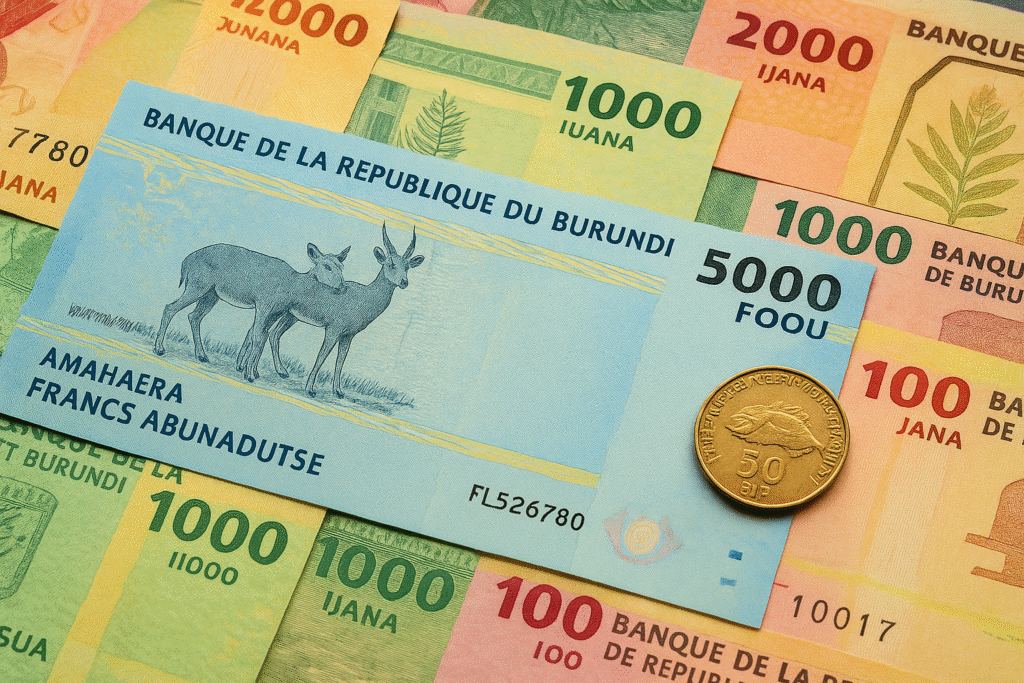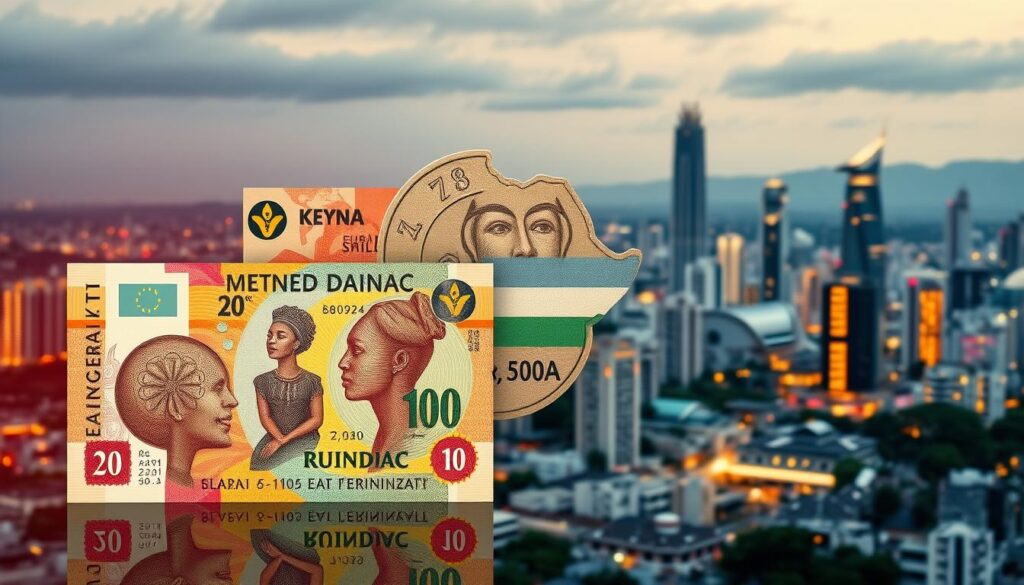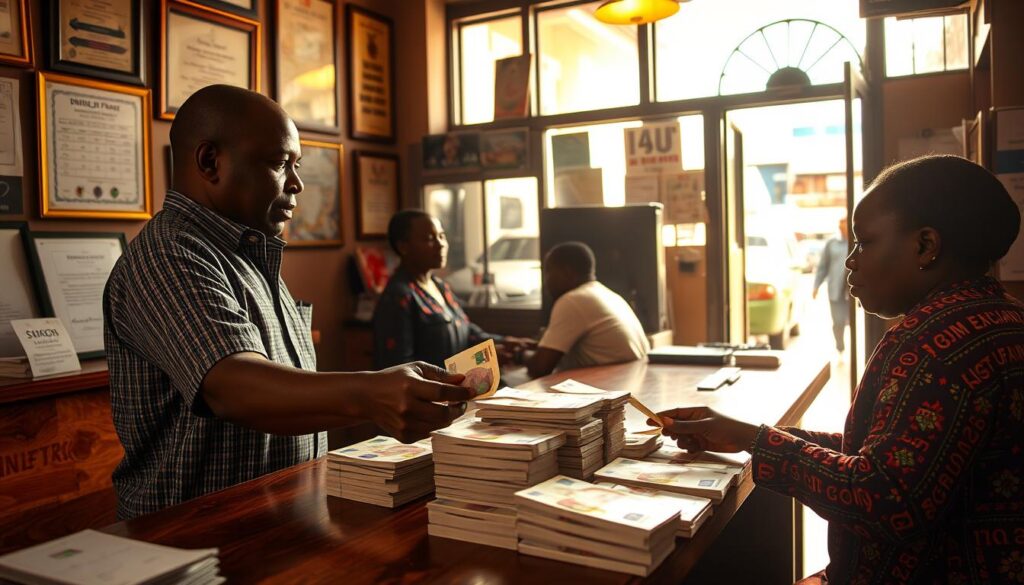
The Burundian franc is the official currency of Burundi, a small country in East Africa. It has a rich history and plays a big role in the country’s economy. Knowing about the Burundian franc is key for anyone interested in Burundi’s financial scene.
The Burundian franc, symbolized by FBu and with the ISO 4217 code BIF, is issued by the Bank of the Republic of Burundi. This central bank is in charge of it. The franc is essential for Burundi’s economy and is used in daily transactions.
Key Takeaways
- The Burundian franc is the official currency used in Burundi.
- It is denoted by the symbol FBu and has the ISO 4217 code BIF.
- The Bank of the Republic of Burundi is responsible for issuing the Burundian franc.
- The currency plays a crucial role in Burundi’s economy.
- Understanding the Burundian franc is essential for navigating Burundi’s financial landscape.
The Burundian Franc: Burundi’s Official Currency
The Burundian franc is Burundi’s official currency. It is denoted by the symbol FBu and has the ISO 4217 code BIF. Knowing about the Burundian franc is key for anyone dealing with money in Burundi or its economy.
Basic Information and Currency Code BIF
The Burundian franc has been used since Burundi became independent. The ISO 4217 standard gives the Burundian franc the code BIF. This code is important for international money dealings and currency swaps.
Using the BIF code makes it easier to change the Burundian franc into other currencies. This helps with international trade and travel.
The Burundian Franc Symbol and Visual Characteristics
The symbol for the Burundian franc is FBu. This symbol is used locally and in financial settings to show the currency.
The look of the Burundian franc, including its banknotes and coins, shows off the country’s culture and history. The design of the currency is important for its realness and beauty.
Historical Development of the Burundian Franc
The Burundian Franc’s history is closely tied to Burundi’s path to freedom. The country’s economic growth has been shaped by its currency. This has changed over time to fit the country’s needs.
Colonial Currency History Under Belgian Rule
During the Belgian colonial era, Burundi used the Belgian Congo franc. This was common in many African colonies. The currency was often linked to the colonial power’s money or a regional currency.
The Belgian Congo franc in Burundi showed the region’s economic tie under colonial rule. This period set the stage for a national currency after independence.
Post-Independence Currency Evolution Since 1962
After gaining freedom in 1962, Burundi got its own currency, the Burundian Franc. This was a big step for the country’s economy. It showed Burundi’s independence and its control over money matters.
The Burundian Franc has changed a lot since 1962. It has updated its look, security, and values to match the country’s economic state.
| Year | Event | Impact on Currency |
|---|---|---|
| 1962 | Independence from Belgium | Introduction of the Burundian Franc |
| Late 1960s | Economic adjustments | Changes in currency denominations |
| Recent Years | Modernization efforts | Enhancements in currency security features |
The history of the Burundian Franc shows Burundi’s economic journey. It highlights the country’s efforts to have a stable currency. Knowing this history helps us understand the Burundian Franc’s role in the country’s economy today.
Which Currency Does Burundi Use Today: A Closer Look
The Burundian Franc is the official currency in Burundi. It comes in various denominations. This makes it easy for people to handle different amounts of money.
Current Denominations of Coins and Banknotes
The Burundian Franc has coins of 1, 5, 10, and 50 francs. These coins are perfect for small purchases. They play a big role in the country’s money system.
Banknotes range from 100 to 10,000 francs. The higher values are for big deals. The lower ones are for daily shopping.
Security Features and Design Elements
The Burundian Franc has security features and design elements to fight fake money. The Bank of the Republic of Burundi keeps these up to date. This makes the money safe and reliable.
Some security features include:
- Watermarks
- Holographic strips
- Microprinting
These features not only make the money secure. They also show off Burundi’s culture and identity.
The designs on the money and coins tell stories of Burundi’s past, culture, and success. The designs are updated often. This keeps the currency looking modern and safe.
The Burundi Central Bank and Currency Management
The Bank of the Republic of Burundi is key to Burundi’s economic health. It manages the Burundian franc and keeps the financial system stable.
Structure and Functions
The Bank of the Republic of Burundi issues currency and sets monetary policy. It also watches over banks and financial groups. Its setup ensures it acts independently and fairly, which is crucial for trust and financial goals.
The bank does a lot, like handling foreign exchange and keeping the economy stable. It also looks after payment systems. This helps the country grow economically.
Monetary Policy and Currency Regulation
The Bank of the Republic of Burundi makes and carries out monetary policy. It fights inflation, keeps the economy stable, and boosts growth. Its plans for the Burundian franc keep it strong and reliable.
The bank’s choices on money and interest rates shape the economy. It helps avoid financial problems and keeps trust in the franc.
By managing the franc well and making smart monetary policies, the Bank of the Republic of Burundi helps the economy grow and stay strong.
Exchange Rates and Value of the Burundian Franc
Exchange rates are key in figuring out the Burundian franc’s worth in the world market. The rates against USD and EUR are especially important for trade and travel.
Current Exchange Rates Against USD, EUR, and Regional Currencies
The current exchange rate of the Burundian franc against major currencies is as follows:
| Currency | Exchange Rate (1 BIF =) | Exchange Rate (1 Currency = BIF) |
|---|---|---|
| USD | 0.00054 | 1850 BIF |
| EUR | 0.00046 | 2170 BIF |
| KES (Kenyan Shilling) | 0.045 | 22 BIF |
| TZS (Tanzanian Shilling) | 0.0013 | 770 BIF |
Historical Exchange Rate Performance
The Burundian franc’s past exchange rates show the country’s economic stability and trends in the foreign exchange market. Over time, the franc has seen ups and downs against major currencies. This is due to various economic and political factors.
In 2020, the franc’s rate against the USD was steady, with 1 USD being about 1850 BIF. But in earlier years, the rate changed, showing shifts in Burundi’s economy and global trends.
Knowing these changes is vital for businesses and people dealing with foreign exchange. It helps them make smart choices about currency exchange and investments.
The Burundian Franc in East African Economic Integration
Burundi’s economy is linked to the East African Community through its currency, the Burundian franc. As a member, Burundi works with Kenya, Tanzania, Uganda, and others. They aim to boost trade and economic cooperation.

Comparison with Kenyan, Tanzanian, and Ugandan Currencies
The Burundian franc is among the currencies in the East African Community. Comparing it with the Kenyan, Tanzanian, and Ugandan shillings shows each country’s economic state. Exchange rates against the US dollar and euro reveal their strengths and weaknesses.
Currency comparison is key to understanding the region’s economy. It highlights areas for cooperation and challenges in currency harmonization.
East African Community Currency Harmonization Efforts
The East African Community wants to make currencies easier to use across borders. This means standardizing currency regulations and making it simpler to do business. Harmonizing currencies is a big task that needs teamwork to achieve stability and lower costs.
The EAC is working on policies for stable exchange rates and easier currency exchange. These steps aim to improve economic ties among members, including Burundi.
Economic Challenges and the Burundian Franc’s Stability
Burundi’s economy faces many challenges that affect its currency, the Burundian franc. The health of the economy is linked to the currency’s value and stability.
Inflation and Purchasing Power Concerns
Inflation is a big problem in Burundi. It makes the Burundian franc less valuable. This hurts both consumers and businesses.
Inflation Trends: Burundi’s inflation rates have changed over time. These changes are due to both local and global factors. Knowing these trends helps us understand the currency’s stability.
| Year | Inflation Rate (%) | Impact on Burundian Franc |
|---|---|---|
| 2020 | 3.5% | Moderate inflation |
| 2021 | 4.2% | Rising inflation concerns |
| 2022 | 5.1% | High inflation, reduced purchasing power |
Impact of Political and Economic Developments on Currency Value
Politics and economics both play big roles in the Burundian franc’s value. Political instability and global price changes can affect the currency.
Economic diversification and political stability can help keep the currency stable. But, political unrest or poor economic management can cause the currency to lose value.
The stability of the Burundian franc is complex. It’s influenced by many economic and political factors. Understanding these challenges is key to predicting the currency’s future.
Using the Burundian Franc: Practical Information for Visitors and Businesses
The Burundian franc is key to Burundi’s economy. Knowing how to use it is important for both visitors and businesses. It makes your stay better and helps with money matters.
Currency Exchange Options and Best Practices
You can exchange money for Burundian francs at banks, currency offices, and some hotels. It’s smart to compare exchange rates to find the best deal. Also, knowing the current rates and fees helps avoid losing money.
For a safe exchange, use authorized currency exchange services. These are checked by the Bank of the Republic of Burundi. They make sure your money is safe and follow the rules.

Banking Infrastructure and Payment Systems
Burundi’s banking system is growing, with many banks offering services. The Bank of the Republic of Burundi keeps the system stable and secure.
Payment systems in Burundi are also improving. Digital payments, like mobile money, are becoming more common. They make transactions easier, both locally and abroad.
- Major banks in Burundi offer a range of services, including account management and currency exchange.
- Mobile money services are becoming increasingly popular, allowing for easy transactions.
- The Bank of the Republic of Burundi regulates and oversees the country’s financial institutions.
Digital Transformation of the Burundian Franc
The financial scene in Burundi is evolving with digital currency advancements. Burundi is embracing mobile money and electronic payments to modernize its financial system. This change boosts financial inclusion and makes transactions easier for everyone.
Mobile Money and Electronic Payment Adoption
Mobile money has been a big step for financial inclusion in Burundi. Now, many people can use mobile money services. This breaks down old barriers to financial access. Mobile money lets users manage money, pay bills, and send funds via their phones, offering a safe and easy cash alternative.
Electronic payment systems are also being added to the financial setup. They make transactions quicker and safer. This is key for Burundi’s economy, as it boosts efficiency and cuts down on cash use.
Future Currency Innovations and Central Bank Digital Currency Prospects
The Bank of the Republic of Burundi is looking into a central bank digital currency (CBDC). A CBDC could change the financial scene by offering a digital Burundian Franc for transactions, savings, and more.
Introducing a CBDC could bring many benefits. It could improve financial stability, help with monetary policy, and increase access to finance. It also gives the central bank more ways to manage the economy and tackle financial issues.
As Burundi moves forward with digital transformation, the future of the Burundian Franc is bright. New innovations could greatly affect the country’s financial system and economy.
Conclusion: The Future of the Burundian Franc
The future of the Burundian franc is linked to Burundi’s economy and its integration efforts. As Burundi grows and joins the global economy, the franc will change. The Bank of the Republic of Burundi is key in managing the currency and keeping the economy stable.
It’s important for businesses and investors to understand the franc’s future. The currency’s outlook will depend on many things, like economic policies and global conditions. A stable franc is crucial for Burundi’s growth.
Burundi’s economic outlook is positive, thanks to the government’s efforts. These efforts aim to boost stability and growth. As Burundi advances, the franc is expected to become more stable, improving the country’s economic standing.
FAQ
What is the official currency of Burundi?
The official currency of Burundi is the Burundian franc.
What is the currency code for the Burundian franc?
The currency code for the Burundian franc is BIF, according to the ISO4217 standard.
What is the symbol used to denote the Burundian franc?
The symbol used to denote the Burundian franc is FBu.
Who issues the Burundian franc?
The Burundian franc is issued by the Bank of the Republic of Burundi, the country’s central bank.
What are the available denominations of the Burundian franc?
The Burundian franc is available in several denominations of coins and banknotes.
How is the value of the Burundian franc determined?
The value of the Burundian franc is determined by its exchange rate against other currencies.
What is the role of the Bank of the Republic of Burundi in managing the Burundian franc?
The Bank of the Republic of Burundi is responsible for issuing currency, implementing monetary policy, and regulating banks and other financial institutions.
How is the Burundian franc affected by inflation?
Inflation erodes the purchasing power of the Burundian franc, affecting its stability.
What is the significance of the Burundian franc in East African economic integration?
The Burundian franc plays a role in regional economic integration efforts within the East African Community.
Are there any plans to introduce a central bank digital currency (CBDC) in Burundi?
The potential introduction of a central bank digital currency (CBDC) is being explored, which could further modernize the currency and payment systems in Burundi.
How can visitors and businesses exchange currency in Burundi?
There are various options for exchanging currency in Burundi, and following best practices can help avoid potential issues.
What is the current state of digital payment systems in Burundi?
The Burundian franc is undergoing a digital transformation, driven by the adoption of mobile money and electronic payment systems.

Adam G
This post was created by Adam G, a seasoned financial writer with a passion for explaining currency exchange and market movements

1 thought on “Which Currency Does Burundi Use? Discover the Burundian Franc and Its Role in East Africa”